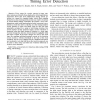Free Online Productivity Tools
i2Speak
i2Symbol
i2OCR
iTex2Img
iWeb2Print
iWeb2Shot
i2Type
iPdf2Split
iPdf2Merge
i2Bopomofo
i2Arabic
i2Style
i2Image
i2PDF
iLatex2Rtf
Sci2ools
DFT
1997
IEEE
1997
IEEE
An IDDQ Sensor for Concurrent Timing Error Detection
Abstract— Error control is a major concern in many computer systems, particularly those deployed in critical applications. Experience shows that most malfunctions during system operation are caused by transient faults, which often manifest themselves as abnormal signal delays that may result in violations of circuit element timing constraints. We present a novel complementary metal–oxide–semiconductor-based concurrent errordetection circuit that allows a flip-flop (or other timing-sensitive circuit element) to sense and signal when its data has been potentially corrupted by a setup or hold timing violation. Our circuit employs on-chip quiescent supply current evaluation to determine when the input changes in relation to a clock edge. Current through the detection circuit should be negligible while the input is stable. If the input changes too close to the clock time, the resulting switching transient current in the detection circuit exceeds a reference threshold at the time of ...
| Added | 06 Aug 2010 |
| Updated | 06 Aug 2010 |
| Type | Conference |
| Year | 1997 |
| Where | DFT |
| Authors | Christopher G. Knight, Adit D. Singh, Victor P. Nelson |
Comments (0)

